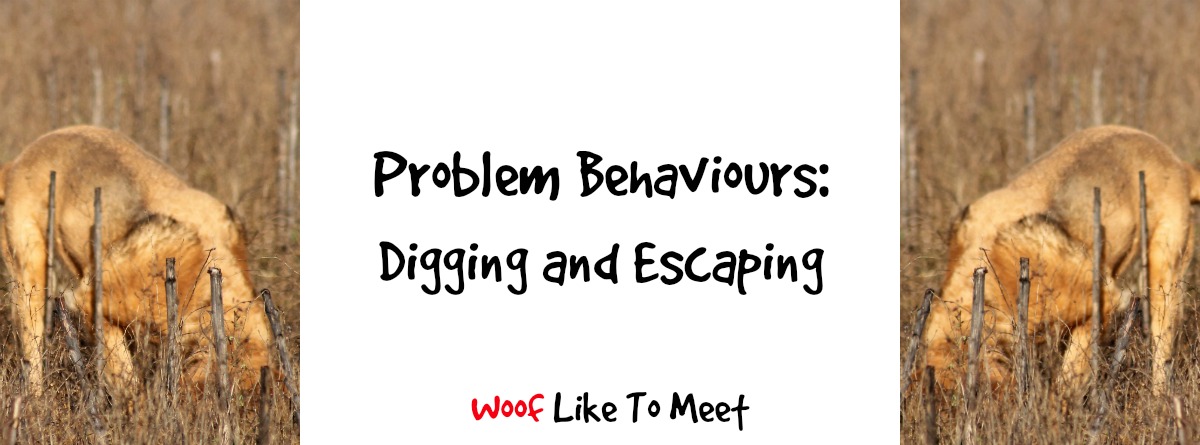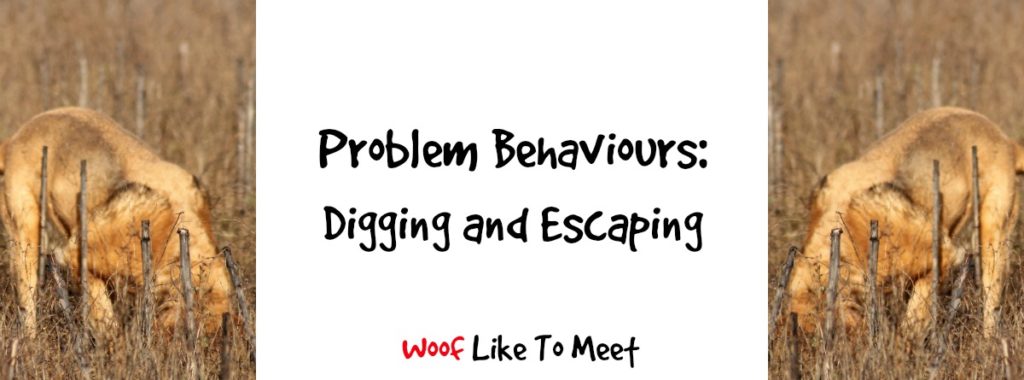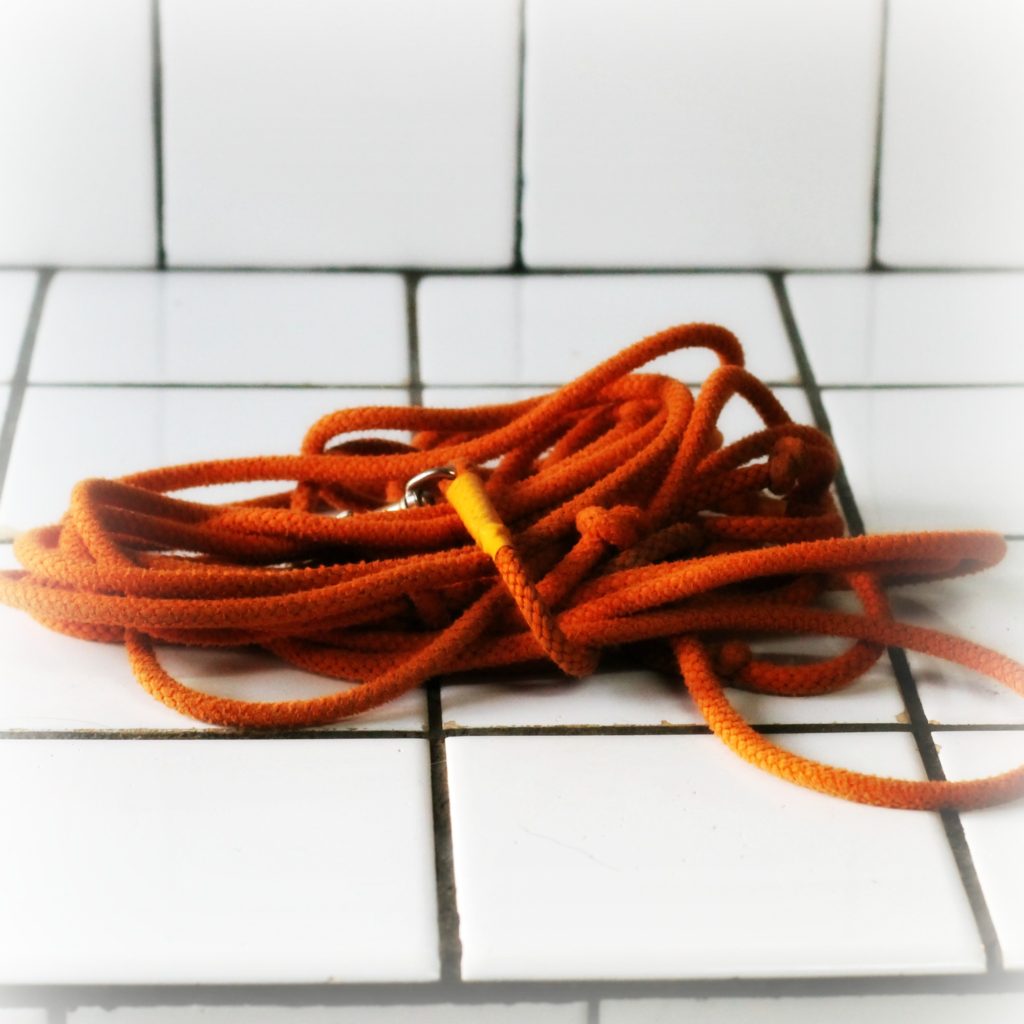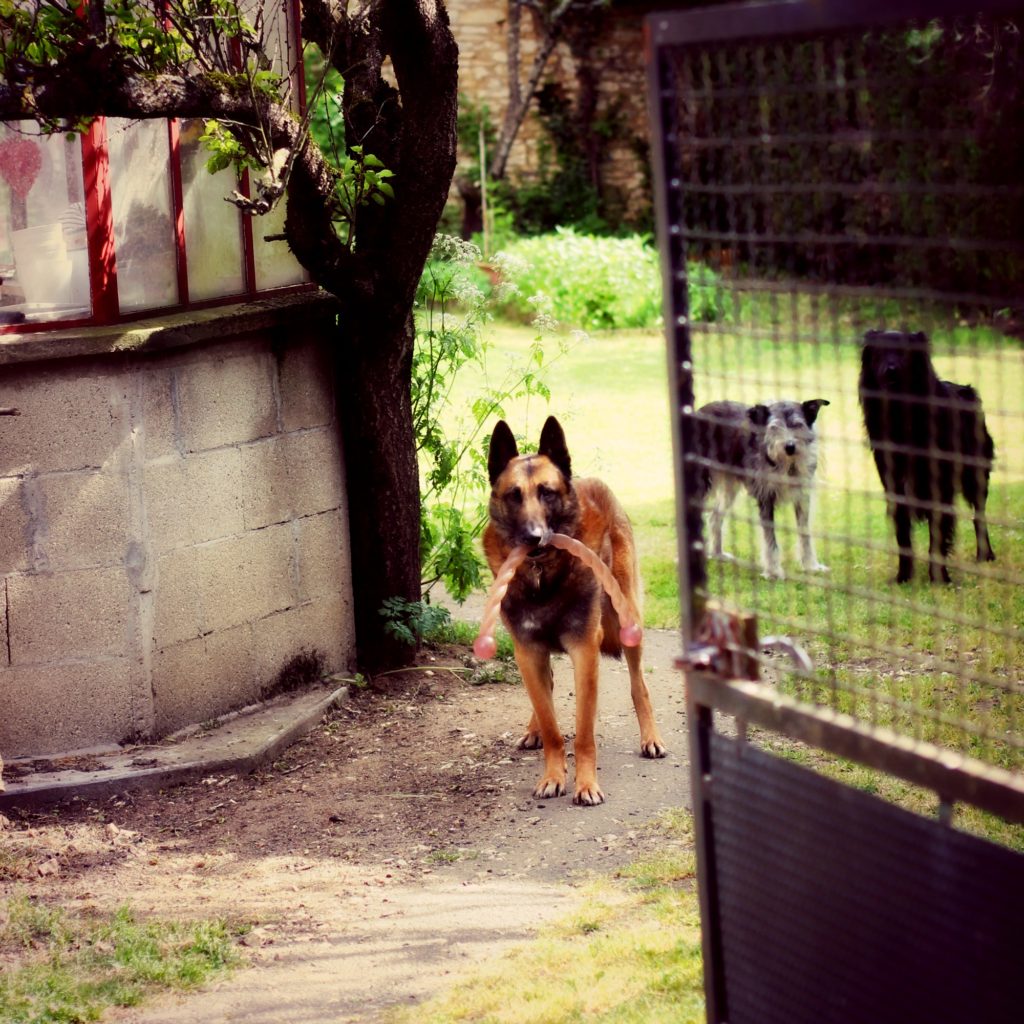Okay… two very different behaviours, sometimes linked (if you’re a dog involved in The Great Escape) and mostly not. However, they have a similar solution so I’m sticking them together for that reason and lumping them under “unwanted behaviours in the yard”.
Digging
I had a digger. Ralf, who also ate a month’s supply of vitamins, a kilo of sugar and once dragged me on my arse through a cow field to see a dog on the other side. He didn’t just dig. He sculpted tank traps. He excavated. He hollowed out moats, quarried for loot, dug for victory. That dog loved digging. My beautiful flat paddock was filled with craters and holes.
And I let him.
He was 12 years old and had been a working guard dog all his life. If you can’t enjoy the simple pleasures of a hole in your retirement, when can you?
Had he been younger, I’d have put a stop to his behaviour. When you’re trying to navigate bunkers and trenches on a lawnmower, you get a little cross. As it was, he taught Amigo and Heston the simple joy of digging too. Nothing like a little social contagion between friends. The joy of digging was easily stopped once Ralf died, and my garden soon returned to its former flatness.
So why do dogs dig?
There are so many interesting reasons behind this behaviour.
First and foremost, it’s in a dog’s DNA. You don’t need to teach a dog to dig (though it helps to have a mentor, doesn’t it Heston and Amigo?) and you’ll find dogs who are natural diggers. It’s instinctive and ancestral. Some dogs do different kinds of digging… Tilly ‘digs’ in the bed or the couch before she lies down. Amigo scrabbles for rabbits. This primeval behaviour could be a throw-back perhaps to their canine cousins who hollow out a space to sleep in as well as those who dig to find hidden prey. It could be a den to raise their young in and it could be a way to find a meal. It’s what scientists call a motor pattern, and it means that all dogs know how to do it instinctively.
There can be other reasons for different types of digging, so you need to know what kind of digging your dog does.
Is it more like clearing a space or making a dirt nest? They can do it to clear a space of grass (Tilly does this) perhaps clearing it of insects, or to enjoy the cooler dirt beneath. Or they can do it in colder temperatures to make a kind of protective space against the elements. Some digging precedes resting or raising the young, and that’s a form of digging that you might see your dogs doing.
Do they run off with your socks and hide them? Dogs also dig to bury stuff. If you’ve got a little hoarder in your midst (that’s you, Tilly!) you may find that they bury things that they unearth later. Tilly once buried a bread roll. She unearthed it when it was green and moldy, and then she guarded that moldy-old bread-roll as if it were a leg of ham. We also have a burial bone that Heston, Tilly and Amigo have all buried and unearthed. In fact, when Tilly used to bury her stuff, Molly would unearth it and re-bury it. Poor Tilly was a confused cocker indeed. Digging can therefore serve as a kind of safety-deposit-box for dogs. If they are a bit insecure and needy, you may find them taking off with something that smells of you and burying their stash.
Is your dog digging because they’ve a sneaking suspicion there’s a critter to be had? Dogs will also dig to unearth stuff. Obviously. If you’ve buried treasure, you’ll want to dig it up at some point. But it might not be a treasure you buried yourself. Digging is a way of unearthing mice, rats, voles, shrews, moles and even rabbits, coypu and badgers. If it lives in a hole, a dog might like to eat it. Digging is a counter-part in the predatory motor sequence to chasing. Heston lives to chase hare – but never digs for rabbit. Amigo will happily dig away and excavate a hole if he thinks something’s down there.
Does your dog do a frantic and exuberant scrabble for no good reason at all? Digging can be a way of passing time and relieving boredom. It’s a fun pastime for a lot of dogs. Got an hour to spare? Feel a sudden surge of energy? Digging is a great workout for a dog. You know how occupied your kids are with a bucket and spade on the beach? It’s the same for some dogs. If it’s frantic, joy-filled scrabbling sometimes coupled with a mad figure-of-eight run, digging is just a dog’s way of celebrating how good it is to feel alive.
Understanding why your dog digs can help find a solution. For the insecure dog who is burying a stash, only giving them instantly consumable chews and clearing up their toys can help eradicate the habit. When nothing needs interring, there’s no need to dig. If your dog is digging in the yard, it may be hot and trying to find a cool spot, like you turning your pillow over in the summer to enjoy the coolness of the underside. In that case, putting up a parasol, using a cool mat or keeping a cooler area in shade will help get rid of a summertime digging problem. If your dog is a yard dog who lives outside in the winter, you may find them excavating a hollow to keep them away from the wind or to find a warmer spot. In this case, a shelter or nest of blankets would help.
For dogs who are ‘digging’ in their bedding before they sleep, most of them only do it a couple of times before settling down. It’s not typically a behaviour that people want to or need to eradicate.
For others, who are digging to escape, addressing the need to escape (below) will help with the desire to dig. In that case, digging is a means to an end, rather than a pleasure in itself.
But what about dogs like Ralf, who dig for the sheer joy of digging, or dogs who dig because there’s something moving down there, dammit!?
Supervision is vital here. The moment they start to dig, you have to be able to intervene and distract. That means watching them all the time they are outside and not turning your back for a second. Don’t worry – you’re not going to have to do it for long, but you will have to do it. If a dog is unsupervised, you’ve no way of intervening when you need to, so you will need to be vigilant. For my dogs, post-Ralf, supervising them in the garden and introducing a range of new toys helped them ‘forget’ about how fun digging can be. Sure, it meant keeping them in a closed yard until the urge had passed, unless they were out in the field with me being supervised directly, but a few days of complete vigilance and supervised outdoor time gives you chance to intervene. It also stops your dog getting the pleasure they would from digging, so it stops them from self-reinforcing.
Your aim is to watch for the behaviour, disrupt it the moment the dog paws at the ground or seems interested in the ground, and then redirect the dog with another behaviour that is a fun way to expend energy. Be careful though. You don’t want your dog to decide that it has to dig in order to get you to play ball. Make sure there is a change in behaviour before you throw a ball or play chase.
Bear in mind that if your dog is digging because it’s after a subterranean creature, it can be really difficult to intervene and distract. You know how your dog’s recall evaporates when they’re in the midst of a chase? Digging can be just the same. Easier in some ways, because they’re not running off twice as fast as you are. But hard just the same. In this case, you could find the digging is less if you find ways to move those blessed underground creatures on. But the following technique works too…
The key to success is to manage the environment, making sure your dog does not have access to the places they like to dig. Fencing is your friend, even if it’s only temporary. This works even better if you build in a place for them to dig, encouraging them to dig in a new, approved spot. Just make sure that it’s a good spot – broken nails and bloody paws are the last thing you want. Remember that digging is a pastime for dogs like this, and you can easily provide another pastime that encourages your dog to use another skill, like chewing, puzzle toys or a whole load of games. If you’ve got a dog who’s got a particularly hard-wired digging behaviour, like a terrier or a dachshund, then you may find that their urge to dig is better than your ability to supervise. Instead of fighting an uphill battle, go with the flow and provide your dog with a place where they can dig to their heart’s content. Some sites will inevitably tell you that dogs like freshly turned earth, but Ralf would dig in hard, compacted soil as often as not. Some dogs like sand, some like harder substances… pick whichever your dog likes to dig in and seek to replicate it in a ‘dig all you want’ zone.
But if they only dig if they’re after a creature, you either need to restrict access to that spot or find ways to move those creatures on. Personally speaking, I’m a fan of creatures in general, so the badgers who pass through my garden are as welcome as the birds. The moles are messy guests but they’re welcome here too. For me, if I had a digger, restricting access would be crucial as well as supervising when the dog is in the garden. Killing the underground creatures is out of the question, and there’s no easy way to relocate a determined badger.
Managing the environment, phasing out habits, providing digging spaces, making sure nervous dogs feel secure and energetic dogs have something to do should really help eradicate the bunkers on the lawn.
If your dog is digging as a means to an end, read on…
Escaping
If your dog is escaping regularly from the garden, you’ve also got to think about the causes of that behaviour in order to eradicate it.
Younger puppies are unlikely to escape, but they can wander off and get lost, especially if they are confident puppies and your property is not secure. Exploring is part-and-parcel of growing up. Adolescent dogs may seek opportunities to escape if they are unsupervised, bored or hormonal. Picture your teenager sneaking out of the house of an evening to hook up and have fun, and you get the picture. Adult dogs may escape if they are hormonal, and elderly dogs may escape as part of canine cognitive dysfunction.
Hormones are a big factor. Contrary to popular belief, it’s not just male dogs that go a-wandering. A female in a yard doesn’t emit THAT powerful a smell that it brings all the boys to the yard. That said, with the right weather conditions, it’s not unlikely that a female outside could attract males from a quarter mile away. As many females get out to go seeking out male company as boys get out to service their needs. One village I went to last year had enormous problems with escapees because one guy let his three unsterilised females wander willy-nilly. As a consequence, every intact male within a quarter mile of their very large roaming area was then desperate to get out as Nature was very certainly calling. If you’ve got an escapee, castration is one way that is very likely to stop the urge to wander if that’s why they’re escaping.
The wind might not just be bringing the scent of mating hormones over your fence: it could also be bringing the smell of creatures. Cats, wildlife, other pets… I don’t need to tell you the sad tale of a Frenchie who escaped, dug a hole through to next door, broke in and ate the guinea pig… if something fun is over the other side of the fence (or, conversely something that makes your dog mad) they might try to escape too.
You also have to look at breed. Some breeds have had their ‘chase’ motor pattern diminished through years of selective breeding. What good would a livestock-guarding breed be if it ran off every time it saw a predator and got the urge to chase it. It’s one reason why beagles don’t guard sheep and why Maremmas aren’t good at hare-coursing. Some breeds are more ‘homey’ than others. Dereliction of duty would be a rubbish skill for any kind of guardian dog or livestock dog. Likewise, a collie or shepherd herding livestock would be useless if it had strong scenting instincts as my dog Heston does. Heston would be a rubbish herder as he’d be easily distracted by a scent of rabbit and disappear just as he was about to bring the sheep into a fold. Genetics can play a strong part in how likely a dog is to stray from a property where boundaries are less secure. If you have an active, curious, tenacious and independent dog bred for any form of hunting, your work is going to be a lot harder than if you’ve got a companion breed or a guardian breed. A shih tzu simply doesn’t have the same genetic drive to escape as a terrier might if he smells a badger beyond the property line.
There are also psychological factors at work. Dogs escape when something upsets them, from time to time. Like us, they vote with their feet. For my geriatric malinois, who was of a very sensitive disposition, he would regularly escape through a hole and wander off. Was he chasing skirt? It’s possible. He was intact and very sensitive to female hormones (I called him the canine womb-detector). He was also going out through well-used badger and rabbit holes in the fence, so he could have detected a smell that he wanted to follow. But given he only went at very specific times, I think it was most likely a vote with his feet. When puppies arrived here on foster, Tobby was off. I’d find him wandering down the road like the Littlest Hobo looking for new friends and a puppy-free home.
Another very powerful reason a dog may escape can be in an attempt to save themselves. I simply cannot tell you the sad number of dogs who have been rehomed from our shelter and then got startled by something and taken to the hills. Fearful dogs present a very high risk indeed of escape. If they are noise-phobic, storm-phobic, anxious, suffering from separation anxiety or scared, a dog will flee. Fight or flight? Flight wins out. This is the saddest form of escape and is better treated with a programme for fearful dogs than it is through the solutions that follow, but they may help too.
A final reason can be boredom and lack of supervision. I said about Tobby wandering off when I got puppies here, and one reason for that might be that he felt less secure here, but it’s also true that puppies are attention-sucks. So is gardening. When you aren’t keeping an eye on your dog and actively supervising them, don’t be surprised if your dog takes advantage of that.
The easiest way to deal with escapes is in managing the environment by which I mean that your dog will need a secure – and interesting – area to keep them in. Our shelter may not be the comfortable and stimulating environment a garden is, but by-and-large, it’s secure. Do dogs get out of their enclosures? Yes, from time to time. I’ve seen dogs use kennels to climb on and hop over, and I’ve seen dogs dismantle the gutter covers to use the gutters to get out. I’ve seen dogs who learn quickly how to flick the catches on the gates and I’ve seen dogs charge people’s legs when they open the gates. I’ve seen dogs shimmy (is that the right word?!) up over the 2m grilles that make the fencing. But I’ve never seen dogs escape from the enclosures we have that are covered over the top and where the gutter grids are fixed, where the gates are padlocked. If a dog can climb over a two-metre fence, rolling tops, inward-sloping panels or a mesh over the top will stop them doing so. If they charge the gate, put a double gate system into place like a kind of airlock. Creating a secure enclosure for your dog may cost you a fair whack, but it will work. A concrete base, a 2m fence, mesh over the top and a double gate entry will stop even the most determined hounds. And you can pretty it up. There’s no reason you can’t put grass over the top of the concrete base, no reason you can’t put artificial turf in there, no reason you can’t fill it with toys. Then, when your dog is in the garden you can keep them on a long-line so they can’t run off.
You can buy 20, 50 and even 100m long-lines from many websites. Sadly, in France, shock collars are often used and promoted as anti-fugue or “anti-escape”. A lead is more reliable than a shock collar for stopping your dog running away, both out of your property and within your property boundaries. For dogs whose impulse to escape is based on a primary emotion such as fear or on a hard-wired predatory instinct, a shock collar or so-called ‘e-fencing’ is unlikely to work. Particularly with dogs who escape because they’re afraid, adding a shock collar or any kind of punishment will worsen the situation, not improve it. Shock collars and electric fencing can also worsen boundary and barrier aggression too.
Why do people choose a shock collar or electric fencing? Because kindness is time-intensive and requires you to actively supervise your dog. It is hard work keeping your eye on your dog at all times or keeping them on a long-line when you want to spend half an hour in your vegetable garden. This is why an outside enclosure is a bonus. For me, it was very easy as the lady who lived here before me was obviously a lover of dogs. Not only is there a fairly secure courtyard (although I’d struggle with a dog who realises you sometimes have to go up to get out as they could probably hop over the barbecue) but there is also a 2m high kennel and pen, which opens up to a 10m x 2m fenced, grassed run with a hatch. I know people might be all ‘oh, but they’re penned!’ … well, people, a garden is a pen. A house is a pen. A garden with walls or fences is just a bigger, prettier, grassier version of a pen. A house is a painted, furnished version of a pen.
Many dogs are rehomed because their owners do not have secure properties, or they are consigned to life on a chain. Every day, I walk past a boxer on a 10m chain, attached to a sad-looking kennel. His owners could so easily build him a run with two bits of fencing. It makes me so sad when I see adverts for dogs “free to a good home… must have secure garden” because it is a problem that is so easily solved.
Over time, if you prevent your escape artist from running away, you may find that their drive to do so is much reduced. This is the same if they are fearful or following some innate urge to chase. You can work on making the home environment reinforcing with lots of games (especially ones that refocus a natural urge, such as playing chase or fetch) and lots of fun stuff to do in the garden. You may find that over several months your dog is looking less to escape than they once did and the habit dies out. But you can never rest on your laurels with a dog who has ever escaped… it only takes one very powerful incentive to run off and you’re back to square one. Vigilance is essential.
If you have a dog that dashes the gate when there are visitors, you can also build in some reinforcement training. I think this is vital for all dogs, personally speaking. I live on a fast main road and a blind bend… if I can’t trust my dogs to stay calm when the gate is opened, the risk of one getting squished is enormous.
It’s not something I’d trust if a cyclist, jogger, dog or herd of cows went by, but for wagons, cars, motorbikes and general traffic, it’s one of the most useful things I’ve taught my dogs. Effel has had a month of gate-training to stop him trotting out into the road when guests open the gate, since he was nearly a squished fosteree last year. Obviously, this kind of reinforcement clicker training isn’t going to solve the problem of a hardened escape artist, but it’s a reliable way of stopping your dogs making a bid for freedom in day-to-day entrances or exits.
Next week, I’ll be exploring ways that you can use to stop your dog from chewing.




